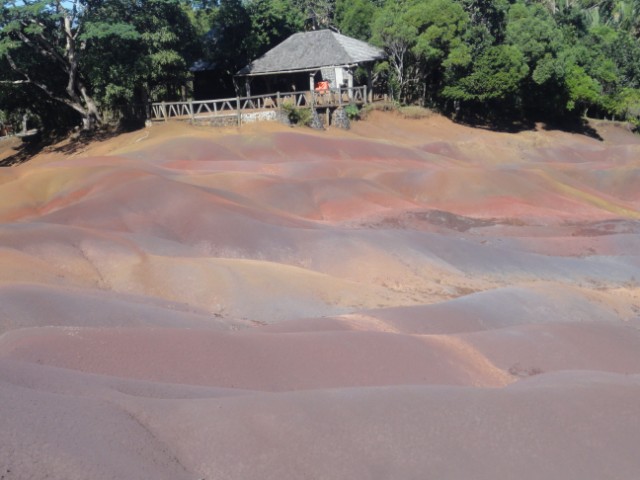The maverick waters of Mauritius
The maverick waters of Mauritius
Direct LINK to Wines in NASHIK When we were on our trip to Mauritius, we never imagined the ways it was going to touch our hearts. On our drive to the hotel, I was fascinated by the never ending fields of sugar cane on either side of the road, right up to the tarred portion. Mauritius is a small island, just 45km in width and 65km in length, of volcanic origin, which explains the interesting elevations of mountain range, waterfalls, cliffs and the exceptional fertile land.
When we were on our trip to Mauritius, we never imagined the ways it was going to touch our hearts. On our drive to the hotel, I was fascinated by the never ending fields of sugar cane on either side of the road, right up to the tarred portion. Mauritius is a small island, just 45km in width and 65km in length, of volcanic origin, which explains the interesting elevations of mountain range, waterfalls, cliffs and the exceptional fertile land.
 The volcano crater is found in Curepipe, a favorite sightseeing place for many locals and tourists. From the crater, you can have a 360-degree view of the town of Curepipe and the coastal plains stretching towards the distant horizon. According to volcano experts, this volcano is not yet dead but 'dormant' and can wake up in thousands years ....
The volcano crater is found in Curepipe, a favorite sightseeing place for many locals and tourists. From the crater, you can have a 360-degree view of the town of Curepipe and the coastal plains stretching towards the distant horizon. According to volcano experts, this volcano is not yet dead but 'dormant' and can wake up in thousands years ....
Historical perspective:
The island of Mauritius was first discovered by Arab sailors, at some time in the 9th century, but the first to colonise the island were the Dutch, in 1598. In 1710, the Dutch abandoned the island, and the French settled there in 1713. They settled on the north-western side of the island and established their main harbor there, Port Louis, the present-day capital of Mauritius. In August 1810, the British tried to take over the island but lost after a fierce battle against the French in the famous Battle of Grand Port. However, the British came back in December 1810 and successfully defeated the French. From then on, the island was renamed Mauritius and remained under British rule until it attained independence on 12 March 1968. In 1835, slavery was officially abolished and, as most of the African slaves chose to abandon the agricultural fields and move to small coastal villages, indentured labourers were brought in from India (Tamilnadu & Bihar) to work in the growing sugar-cane industry.Language:
Most people in Mauritius are bilingual and are equally fluent in English and French. Creole and French are the main languages in the everyday environment and several oriental languages (Bhojpuri is a prominent one) are also spoken.The beaches:
 Mauritius, with its lagoons of a typically tropical sweetness and endless white beaches,is a real paradise for those who want to enjoy the sea. The wonderful Pereybere public beach is popular because of its shopping facilities, restaurants and pubs.
Grand Bay was the first area of the island to fully experience the tourist boom- See pic below.
Mauritius, with its lagoons of a typically tropical sweetness and endless white beaches,is a real paradise for those who want to enjoy the sea. The wonderful Pereybere public beach is popular because of its shopping facilities, restaurants and pubs.
Grand Bay was the first area of the island to fully experience the tourist boom- See pic below.
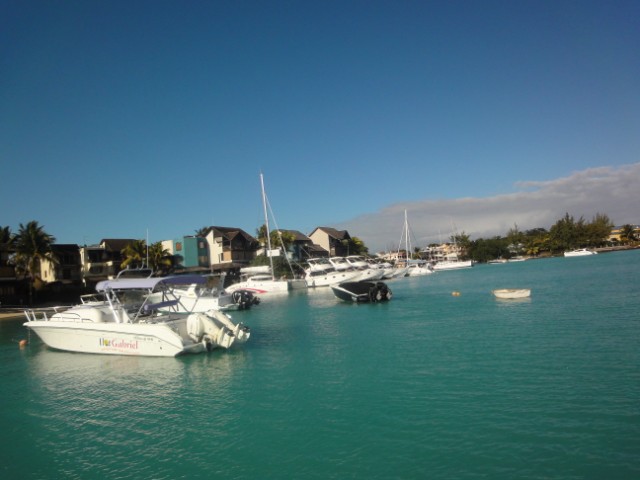 A shopping and leisure paradise Grand Bay also happens to be the area where Mauritians head for when they want a fun-filled night out (restaurants, bars and discos). It was from here that we took a full day trip to Gabriel island, an unforgettable cruising experience on a Catamaran. During the trip, it was unique to watch the changing colors of water. See pic below
A shopping and leisure paradise Grand Bay also happens to be the area where Mauritians head for when they want a fun-filled night out (restaurants, bars and discos). It was from here that we took a full day trip to Gabriel island, an unforgettable cruising experience on a Catamaran. During the trip, it was unique to watch the changing colors of water. See pic below

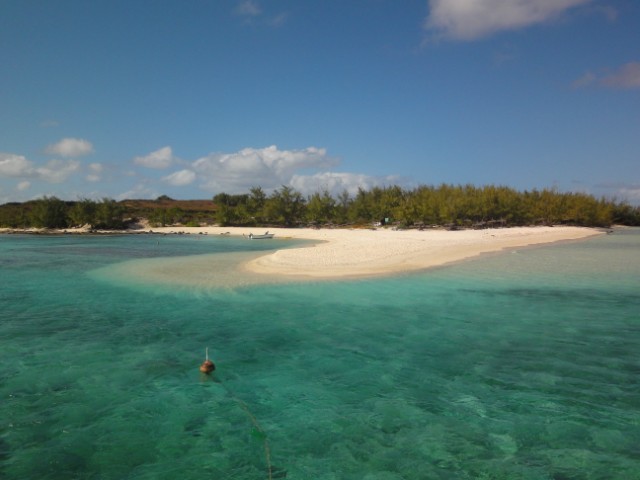 It took us one and a half hours to reach the island, which is famous for if its beautiful unspoiled beaches, with crystal clear water surrounding the entire island. We spent some time in the sea, and it was time for the delicious BBQ lunch buffet set on the beach. I loved the grilled bananas served as sweet dish.
On the adjacent table there were two young couples. Suddenly I saw one of them lying on the ground. I went and told her that if she was unwell I could give her some healing. I did give her Reiki and then we had a nice conversation on alternative healing methods
We explored the island on foot and enjoyed the scenic surroundings, and then it was time for the return journey.
It took us one and a half hours to reach the island, which is famous for if its beautiful unspoiled beaches, with crystal clear water surrounding the entire island. We spent some time in the sea, and it was time for the delicious BBQ lunch buffet set on the beach. I loved the grilled bananas served as sweet dish.
On the adjacent table there were two young couples. Suddenly I saw one of them lying on the ground. I went and told her that if she was unwell I could give her some healing. I did give her Reiki and then we had a nice conversation on alternative healing methods
We explored the island on foot and enjoyed the scenic surroundings, and then it was time for the return journey.
Port Louis
This is the capital city of Mauritius, this is where you also have Unesco heritage site- Aapravasi Ghat, as the first site chosen by the British Government in 1834 for the ‘great experiment' in the use of indentured, rather than slave labour, is strongly associated with memories of almost half a million indentured labourers moving from India to Mauritius to work on sugar canes plantations. Port Loius is historical port town, has a beautiful water front (see pic below) and also the place for shopping of handicrafts etc USEFUL LINK
Ganga Talao:
Ganga Talao or Grand Bassin is a crater lake situated in a secluded mountain area in the district of Savanne, deep in the heart of Mauritius. It is about 1800 feet above sea level. This is an important Hindu pilgrimage site. Many Mauritians walk there during the Maha Shivaratri festival.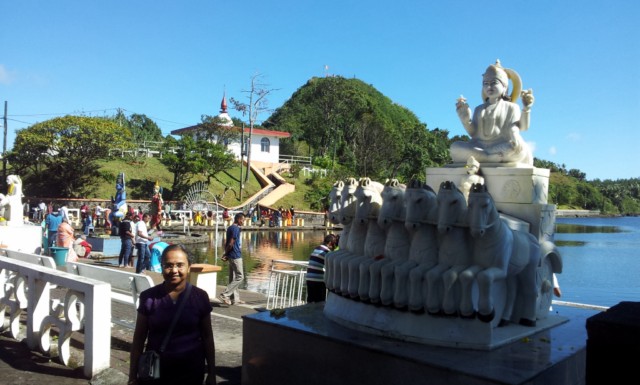

The Sir Seewoosagur Ramgoolam Botanical Garden
This is a popular tourist attraction near Port Louis, and the oldest botanical garden in the Southern Hemisphere, covering an area of around 37 hectares. It is most famous for its giant water lilies.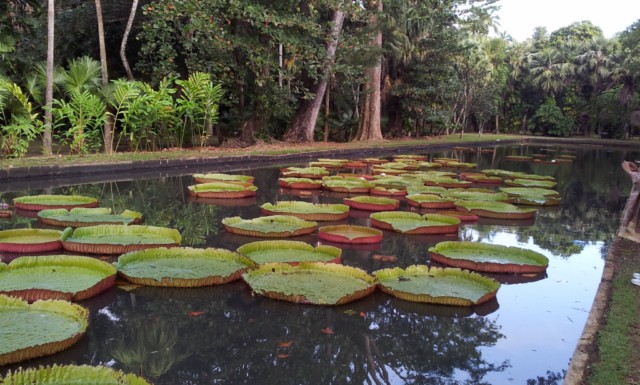

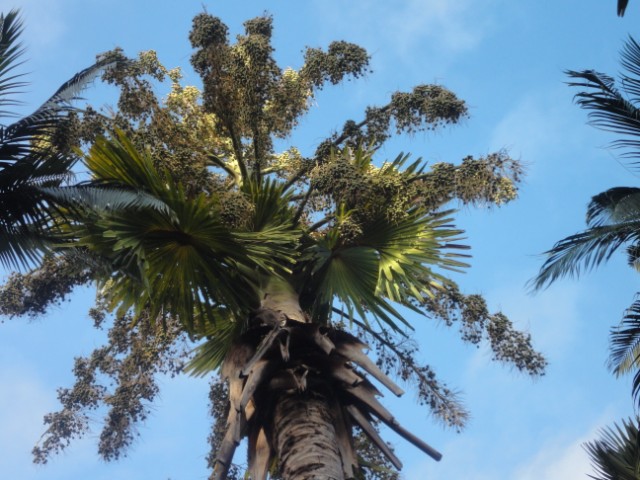
Palm heart salad – a Mauritian delicacy
I was puzzled by the huge plantations of palm trees in Mauritius. On inquiry, I came to know that palm heart salad is a delicacy of Mauritius. The palm tree flowers after seven years. Then the tree is cut and its heart used for making salad. Since now the tree is destroyed, there should be continuous planting of the palms in large numbers.Chamarel- the amazing colored earths
One of the most popular sights on the island, this unusual geological phenomena was formed when volcanic rock cooled at different temperatures, in multicolored layers.